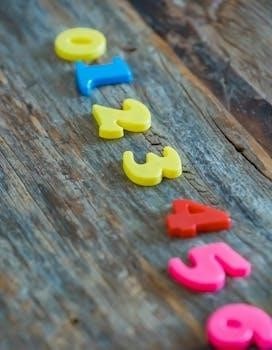Counting Atoms Worksheet PDF⁚ A Comprehensive Guide
Unlocking chemistry’s secrets begins with mastering fundamental concepts. This guide explores how “Counting Atoms Worksheet PDF” resources help students identify and quantify atoms within chemical formulas, a critical skill for understanding chemical compounds and reactions.
Counting atoms in chemical formulas is a foundational skill in chemistry, essential for understanding the composition of molecules and compounds. Chemical formulas use element symbols and subscripts to represent the types and quantities of atoms present. By learning to interpret these formulas, students can determine the number of atoms of each element within a given molecule. This skill is crucial for balancing chemical equations, calculating mole ratios, and performing stoichiometric calculations. Mastering this basic concept provides a solid base for more advanced topics in chemistry, enabling students to predict and understand chemical reactions accurately.
Understanding Subscripts and Coefficients
Subscripts and coefficients are vital in chemical formulas. Subscripts denote the number of atoms within a molecule, while coefficients specify the number of molecules present, essential for balancing equations and understanding quantity.
The Role of Subscripts in Indicating Atom Quantity
Subscripts are the cornerstone of chemical formulas, acting as numerical indicators directly following an element’s symbol. These small numbers reveal the precise quantity of atoms of that specific element present within a single molecule or formula unit of the compound. For instance, in H2O, the “2” subscript denotes two hydrogen atoms bonded with one oxygen atom. Worksheets often test this understanding, requiring students to accurately interpret subscripts to determine a compound’s atomic composition.
The Significance of Coefficients in Chemical Formulas
Coefficients, unlike subscripts, are large numbers placed before a chemical formula. They indicate the number of molecules or formula units of that entire compound present in a given sample or reaction. If 2H2O is present, we have two molecules of water. To calculate total atoms, coefficients multiply the subscripts within the formula. It is important to note that the coefficient affects all elements within the chemical formula, and worksheets emphasize correctly applying coefficients.

Identifying Elements and Radicals
Deciphering chemical formulas involves recognizing element symbols and identifying radicals, which are groups of atoms acting as a single unit. Worksheets help students build proficiency in distinguishing these components.
Recognizing Element Symbols in Chemical Formulas
Element symbols are the shorthand of chemistry, representing individual atoms within a compound. Worksheets emphasize identifying these symbols (e.g., H for hydrogen, O for oxygen) within complex formulas. Students learn to associate each symbol with its corresponding element on the periodic table. This skill is fundamental for accurately counting atoms and understanding the composition of molecules. Practical exercises in these worksheets reinforce the association between symbols and elements, building a solid foundation for more advanced chemistry concepts. Regular practice ensures quick and accurate identification, a crucial step in mastering chemical formulas.
Understanding the Concept of Radicals in Compounds
Radicals, or polyatomic ions, act as single units within chemical compounds. Counting atoms worksheets introduce the concept of radicals, demonstrating how to identify and treat them as a group when determining the total number of atoms. These groups of atoms stay together during chemical reactions. The worksheets emphasize recognizing common radicals like sulfate (SO4) or nitrate (NO3), enclosed in parentheses with a subscript indicating multiple units. Understanding radicals is essential for correctly interpreting chemical formulas and accurately calculating the number of each type of atom present. Practice problems reinforce recognizing and counting atoms within radicals.

Worksheet Applications and Practice Problems
Practice is vital for mastering counting atoms. Worksheets offer exercises in counting atoms in molecular formulas and provide opportunities to hone skills in balancing chemical equations for comprehensive understanding and skill development.
Counting Atoms in Molecular Formulas
Molecular formulas represent the building blocks of compounds, and accurately counting atoms within them is essential. These worksheets guide students in dissecting formulas like H2O or CO2, identifying each element and the quantity of its atoms indicated by subscripts. Through varied examples, students learn to systematically analyze chemical formulas, reinforcing their grasp of chemical composition. Mastering this skill provides a solid foundation for understanding chemical reactions and stoichiometry. Use your periodic table to help you with this assignment, by identifying the elements.
Balancing Chemical Equations Practice
Balancing chemical equations is a cornerstone of chemistry, ensuring mass conservation during reactions. Worksheets offer practice in adjusting coefficients to equalize atom counts on both sides of equations. This involves identifying reactants and products, counting atoms of each element, and strategically multiplying formulas to achieve balance. By working through these exercises, students hone their problem-solving skills and deepen their understanding of chemical change. Balancing equations requires a solid understanding of counting atoms in formulas and applying coefficients.
Advanced Concepts⁚ Mole Ratios and Stoichiometry
Counting atoms paves the way for understanding mole ratios and stoichiometry. These advanced concepts are crucial for predicting reaction yields and understanding limiting reactants, expanding upon the foundational knowledge gained from basic atom counting.
Exploring Mole Ratios in Chemical Compounds
Mole ratios, derived from chemical formulas, represent the proportions of elements within a compound. Understanding these ratios is essential for stoichiometry calculations. Counting atoms accurately is the first step to determining correct mole ratios. Worksheets offer practice in calculating these ratios from formulas. Students learn to interpret chemical formulas to determine the number of moles of each element present. This knowledge underpins quantitative analysis, allowing prediction of product amounts. Mastery of mole ratios is vital for understanding and predicting chemical reactions and their outcomes.
Stoichiometry utilizes mole ratios to predict reaction quantities. Mastering atom counting enables stoichiometric calculations; Limiting reactants dictate the maximum product formed in a reaction. Worksheets provide practice in identifying limiting reactants. Students learn to compare mole ratios to determine which reactant is fully consumed. Identifying limiting reactants is crucial for optimizing reactions. Understanding stoichiometry allows precise prediction of product yields. Worksheets enhance problem-solving skills in quantitative chemistry. Students apply atom counting and mole ratios to solve stoichiometric problems. These skills are fundamental for advanced chemistry topics.

Educational Resources and Worksheets
Diverse resources aid atom counting mastery. Worksheets cater to varied grade levels. They reinforce fundamental concepts. Online resources offer practice and support. Teachers can find materials on platforms like Teachers Pay Teachers.
Availability of Counting Atoms Worksheets for Different Grades
Finding appropriate worksheets is essential for effective learning. Counting atoms worksheets are available for grades 6 through 10. These resources tailor content to students’ evolving understanding of chemical formulas. Worksheets cover molecular formulas, balancing equations, and stoichiometry. Teachers Pay Teachers hosts many resources. The goal is to reinforce fundamental chemistry skills. Worksheets adapt difficulty to grade level. This ensures students grasp atom counting. Such worksheets help prepare them for advanced topics.
Utilizing Online Resources for Practice and Reinforcement
Online resources offer dynamic learning experiences. These platforms enhance understanding of counting atoms. Websites provide interactive exercises, quizzes, and video tutorials. Students can access practice problems covering various complexities. Online resources often include immediate feedback. This allows students to correct mistakes instantly. Many offer printable worksheets for offline practice. Some platforms provide advanced topics like mole ratios. These resources are suitable for grades 6-10. Online tools reinforce classroom learning. They help students master atom counting skills effectively.
PDF Worksheet Features and Functionality
PDF worksheets provide structured learning. They often include clear instructions and organized layouts. These worksheets test a student’s ability to identify and count atoms present in a compound, which is a fundamental skill in chemistry.
Interactive Elements and Answer Keys
Interactive counting atoms worksheets are invaluable. They often include features that enhance student engagement and understanding. Answer keys are a crucial component, offering immediate feedback and enabling self-assessment. This allows students to check their work and identify areas where they need further practice or clarification. Some worksheets may incorporate drag-and-drop activities, multiple-choice questions, or fill-in-the-blank exercises to make learning more dynamic and cater to different learning styles. Interactive elements, combined with answer keys, promote effective learning.
Accessibility and Download Options
Accessibility is key for effective learning tools. Counting atoms worksheets in PDF format are generally very accessible, able to be opened on various devices. Download options are typically straightforward, allowing users to easily save the worksheets for offline use. Many websites and educational platforms offer these worksheets as free downloads, eliminating financial barriers to learning. Clear instructions on how to download and use the worksheets enhance the user experience. Ensuring accessibility and easy download options broadens the reach of these valuable educational resources.

Applications in Chemistry Education
Counting atoms worksheets play a crucial role in chemistry education. These worksheets provide students with practical exercises to reinforce their understanding of chemical formulas and the quantitative relationships within chemical compounds.
Suitable for Grades 6-10
Counting atoms worksheets are versatile educational tools applicable across multiple grade levels, typically spanning grades 6 through 10. The complexity and focus of the worksheets can be adjusted to align with the specific learning objectives and curriculum standards for each grade. Younger students in grades 6-8 can use these to grasp the basics. More advanced worksheets can be used by high school students to learn about mole ratios, stoichiometry, and limiting reactants. They provide a foundational understanding of chemistry.
Reinforcing Chemical Formula Understanding
Chemical formulas are the language of chemistry, and counting atoms worksheets serve as invaluable tools for decoding this language. They reinforce students’ ability to correctly interpret chemical formulas. It helps them identify the elements present and the number of atoms of each element. Through repeated practice, learners develop confidence in their chemical formula comprehension, which is essential for successfully tackling more advanced topics like balancing equations, stoichiometry, and predicting reaction outcomes. Worksheets promote familiarity, leading to enhanced problem-solving skills in chemistry.
